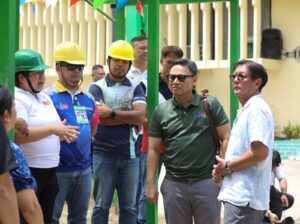The Department of Education (DepEd) on Thursday said it aims to strengthen the disaster preparedness of schools nationwide through initiatives involving technology, training programs, and a guidebook.
“Under the directive of President Bongbong Marcos, our focus is on preparedness,” Education Secretary Juan Edgardo “Sonny” M. Angara said in Filipino in a press release.
“We must ensure that our schools are ready to respond — protecting students and continuity of education before, during, and after any disaster,” he added.
This comes after the magnitude 6.9 earthquake struck Cebu in September, which affected more than 50,000 learners and over 1,400 teaching and non-teaching personnel.
DepEd Region VII Director Salustiano Jimenez, in a statement, said the total damage to schools across the province is projected to exceed P1 billion.
To mitigate the impact of such disasters in the future, the Education department rolled out PlanSmart for Safe Schools with the support of the Department of Science and Technology–Philippine Institute of Volcanology and Seismology (DOST–Phivolcs) and the World Bank.
PlanSmart is a web-based contingency planning application that integrates hazard and risk data from the GeoRiskPH system.
Through the platform, schools will be able to create evidence-based contingency plans aligned with the standards of the Office of Civil Defense (OCD) and the National Disaster Risk Reduction and Management Council (NDRRMC).
School heads and Disaster Risk Reduction and Management (DRRM) coordinators in over 3,000 schools in Greater Metro Manila will receive a series of training sessions related to the platform starting in November 2025, before its nationwide rollout.
DepEd added that it will pilot the M7X School Ready Program, which aims to award a “M7.2 Ready School Seal” to schools that meet the requirements on both structural safety and non-structural preparedness.
The pilot phase will prioritize schools situated along or near the West Valley Fault (WVF), specifically in Metro Manila, Region III, and Region IV-A.
The agency also launched Pillar 1: Safer Learning Facilities Guidebook, a reference manual that promotes “resilient design, safe site selection, and maintenance practices” to help schools adopt an “inclusive, climate-resilient, and child-safe construction standard.”
Meanwhile, to promote uninterrupted learning in disaster-affected areas, DepEd introduced Upgraded Temporary Learning Spaces (UTLS), which are modular classrooms designed to achieve learning continuity as “permanent” schools undergo repair or reconstruction.
“Preparedness is the foundation of resilience. When our schools have adequate equipment, training, and facilities, we can be confident that learning will continue even in the midst of disasters,” Mr. Angara said. — Almira Louise S. Martinez

